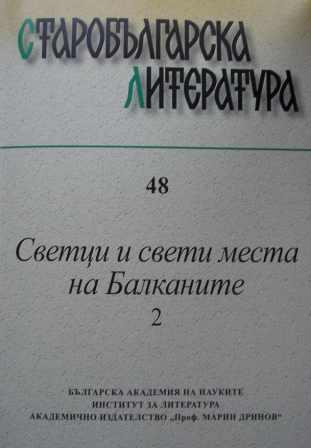Предложения за канонизация на светци през XV в. – примери от византийската, старобългарската и старосръбската литература
Proposals for Sanctification in the 15th Century – Examples from Byzantine, Old Bulgarian and Old Serbian Literature
Author(s): Evelina MinevaSubject(s): History
Published by: Институт за литература - БАН
Summary/Abstract: Тhe article discusses proposals for the official canonization of prominent personalities of the 14th and the 15th centuries in Byzantine, Old Bulgarian and Old Serbian literatures. These texts are the Canon in honor of the Patriarch of Constantinople Euthymios II (26.10.1410–29.03.1416), composed by Mark Eugenikos, bishop of Ephesus (1394/95–1446), the Life and the Office in honor of the same Mark Eugenikos, written by his brother John Eugenikos (1400-ca. 1457), the Encomium of the Patriarch of Tărnovo Euthymios (1320/30 – ca. 1402), written by Gregory Tsamblak (ca. 1364–1419/20), and the Life of the Serbian despot Stefan Lazarević (1370-1427), written by Constantine of Kostenets (ca. 1380 – first half of 15th c.) It should be noticed that the official canonization takes place long after the composition of the relevant texts – in the case of the Patriarch of Constantinople Euthymios II no official canonization takes place at all. The main reason for the postponement, or even the rejection of the proposed canonization, is that all these efforts come from the milieu of the Hesychasts. We should remember that the conflict between Hesychasts and Barlaamites did not end until the fall of Constantinople in 1453. Another reason may be that these proposals for the sanctification came from well-educated high clergy men or state officers and not from the people. The process of canonization might have been delayed due to the fact, that the relevant texts did not contain any miracles, while many historical episodes and facts were mentioned. Therefore these texts have several formal characteristics which do not follow the rules governing the literary genre of medieval hagiographical texts. It should be added that in some cases some texts obligatory for the cult had not yet been composed, for example the short synaxarium vita or the liturgical office in honor of the saint. The above mentioned stylistic and structural peculiarities may have been interpreted as reflecting the pre-renaissance tendencies of their authors; however those tendencies did not lead to a development of new kind of literature as it happened in Western Europe, due to the historically different situation of the Balkan lands in the 15th century.
Journal: Старобългарска литература
- Issue Year: 2013
- Issue No: 48
- Page Range: 196-209
- Page Count: 14
- Language: Bulgarian
- Content File-PDF

